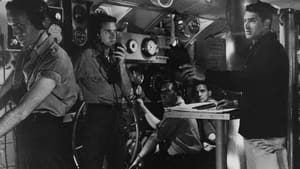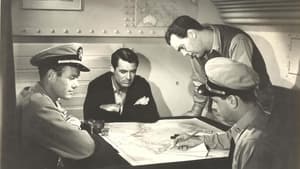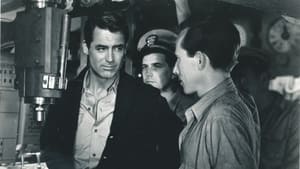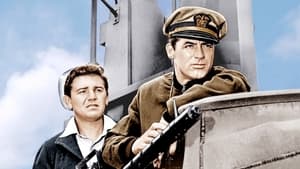Contact: [email protected]
Video Sources 0 Views
- Watch trailer
- Destination Tokyo


Destination Tokyo 1943 First Early Colored Films Version
Synopsis
Table of Contents
ToggleReview: Destination Tokyo (1943) – A Tense and Patriotic WWII Thriller

Introduction
Destination Tokyo, released in 1943, is a gripping World War II thriller directed by Delmer Daves. Renowned for its tense atmosphere, realistic portrayal of submarine warfare, and patriotic themes, this classic film continues to captivate audiences with its suspenseful storyline and stirring performances. In this review, we’ll delve into the thrilling world of Destination Tokyo and its enduring legacy in the annals of war cinema.
Check The Full Colorized Movies List
Check Our Colorized Movies Trailer Channel
Understanding Destination Tokyo (1943): Director, Cast, and Genre
Directed by Delmer Daves, Destination Tokyo features a talented ensemble cast led by Cary Grant, John Garfield, and Alan Hale Sr. The film belongs to the war genre, known for its depiction of the bravery and sacrifice of military personnel during wartime.
Exploring the World of Destination Tokyo (1943): Plot and Characters
Destination Tokyo follows the perilous journey of a U.S. submarine crew as they embark on a top-secret mission to infiltrate enemy waters and gather crucial intelligence for the Allied forces. As they navigate treacherous seas and evade enemy patrols, tensions run high among the crew, testing their courage, camaraderie, and resolve in the face of overwhelming odds.
The Art of Film Colorization
While Destination Tokyo was originally filmed in black and white, its early colorized version adds a new layer of depth to its breathtaking underwater sequences and intense battle scenes. The colorization process enhances the film’s visual impact and captures the stark beauty of the ocean depths with stunning clarity.
Early Colored Films: A Brief History
The history of early colored films is marked by innovation and experimentation as filmmakers sought to enhance the visual appeal of their movies. From hand-tinted frames to pioneering technicolor processes, the evolution of colorization techniques transformed the cinematic landscape, offering audiences a new way to experience the drama and spectacle of war films.
Destination Tokyo (1943) and Its Early Colored Version
The decision to release Destination Tokyo in a colorized format was made with the intention of immersing audiences in the breathtaking beauty of its underwater cinematography and enhancing the film’s visual impact. While some purists may prefer the original black and white version, the early colorized edition of Destination Tokyo adds a new layer of depth to its immersive storytelling and captures the heroism and sacrifice of its characters with breathtaking clarity.
The Debate Over Film Colorization
The debate over film colorization continues to divide audiences and industry professionals alike. While some argue that colorization breathes new life into classic films and makes them more accessible to modern audiences, others maintain that it compromises the artistic integrity of the original work. As technology advances and filmmaking techniques evolve, the debate over colorization remains a topic of ongoing discussion within the film community.
Examining Destination Tokyo (1943) as an Early Colored Film
Viewing Destination Tokyo in its early colorized iteration offers audiences a fresh perspective on its breathtaking underwater sequences and intense battle scenes. The colorization process enhances the film’s visual impact and captures the bravery and sacrifice of its characters with stunning clarity. As viewers are drawn into the harrowing world of submarine warfare, they are treated to a visual feast that immerses them in the drama and spectacle of war.
Influence and Legacy: Destination Tokyo (1943)’s Impact on Cinema
Destination Tokyo is widely regarded as a classic of the war genre that continues to inspire filmmakers and captivate audiences with its thrilling storyline and stirring performances. Its realistic portrayal of submarine warfare and patriotic themes have left an indelible mark on war cinema, shaping the way military films are made and appreciated to this day.
Director’s Cinematic Legacy: Beyond Destination Tokyo (1943)
Delmer Daves’s directorial legacy extends far beyond Destination Tokyo, encompassing a diverse body of work that includes acclaimed films such as Dark Passage and 3:10 to Yuma. As one of the most respected filmmakers of his generation, Daves was known for his ability to craft compelling narratives that explored the complexities of the human condition with depth and nuance. Destination Tokyo stands as a testament to his talent and creativity, solidifying his reputation as one of the great auteurs of classic Hollywood cinema.
Themes Explored in Destination Tokyo (1943)
At its core, Destination Tokyo explores themes of bravery, sacrifice, and patriotism in the crucible of war. Through its tense atmosphere and stirring performances, the film offers a poignant portrayal of the human spirit in the face of adversity, reminding viewers of the courage and resilience of those who serve their country with honor and distinction.
Reception and Controversy Surrounding Destination Tokyo (1943)
Upon its release, Destination Tokyo received widespread critical acclaim for its realistic portrayal of submarine warfare, gripping storyline, and stirring performances. While the decision to release the film in a colorized format sparked debate among purists, its enduring popularity has cemented its status as a timeless classic of the war genre.
Where to Watch Destination Tokyo (1943) Online
For those eager to experience Destination Tokyo for themselves, the film is readily available on popular streaming platforms such as Amazon Prime Video, Google Play Movies, and iTunes. Whether viewed in its original black and white format or its early colorized iteration, Destination Tokyo offers a cinematic experience that is both thrilling and visually stunning.
FAQs About Destination Tokyo (1943)
1. Is Destination Tokyo based on a true story?
No, Destination Tokyo is a fictional film that explores the challenges and sacrifices faced by U.S. submarine crews during World War II. While the film’s storyline may draw inspiration from real-life events, its characters and plot are works of fiction.
2. Who starred in Destination Tokyo?
Destination Tokyo stars Cary Grant in the role of Captain Cassidy, the courageous and resourceful leader of the submarine crew. He is supported by a talented ensemble cast, including John Garfield, Alan Hale Sr., and Dane Clark.
3. What is the central message of Destination Tokyo?
At its core, Destination Tokyo celebrates the bravery, sacrifice, and patriotism of U.S. submarine crews during World War II. Through its tense atmosphere and stirring performances, the film pays tribute to the courage and resilience of those who served their country with honor and distinction in the crucible of war.
4. Why was Destination Tokyo released in a colorized format?
The decision to release Destination Tokyo in a colorized format was made with the intention of immersing audiences in the breathtaking beauty of its underwater cinematography and enhancing the film’s visual impact. While some purists may prefer the original black and white version, the early colorized edition of Destination Tokyo adds a new layer of depth to its immersive storytelling and captures the heroism and sacrifice of its characters with breathtaking clarity.
5. What is the legacy of Destination Tokyo?
Destination Tokyo is widely regarded as a classic of the war genre that continues to inspire filmmakers and captivate audiences with its thrilling storyline and stirring performances. Its realistic portrayal of submarine warfare and patriotic themes have left an indelible mark on war cinema, shaping the way military films are made and appreciated to this day.
6. Are there any sequels or remakes of Destination Tokyo?
No, there have been no official sequels or remakes of Destination Tokyo. However, the film’s enduring popularity has inspired countless reinterpretations and homages in various media. Nonetheless, none have captured the tense atmosphere and stirring performances of the original 1943 classic.
7. Where can I watch Destination Tokyo online?
For those eager to experience Destination Tokyo for themselves, the film is readily available on popular streaming platforms such as Amazon Prime Video, Google Play Movies, and iTunes. Whether viewed in its original black and white format or its early colorized iteration, Destination Tokyo offers a cinematic experience that is both thrilling and visually stunning.
Conclusion
In conclusion, Destination Tokyo (1943) stands as a gripping World War II thriller that continues to captivate audiences with its tense atmosphere, realistic portrayal of submarine warfare, and patriotic themes. Whether viewed in its original black and white format or its early colorized iteration, Delmer Daves’s insightful direction and the stirring performances of the cast offer a cinematic experience that is both thrilling and visually stunning. As viewers are drawn into the harrowing world of submarine warfare, they are treated to a poignant reminder of the courage and sacrifice of those who served their country with honor and distinction in the crucible of war. Destination Tokyo remains a timeless classic that continues to inspire and uplift audiences around the world.















